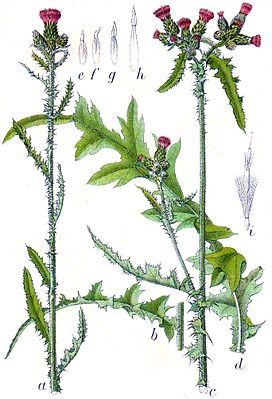Marsh thistle
| Marsh thistle | ||||||||||||
|---|---|---|---|---|---|---|---|---|---|---|---|---|

Marsh thistle ( Cirsium palustre ) |
||||||||||||
| Systematics | ||||||||||||
|
||||||||||||
| Scientific name | ||||||||||||
| Cirsium palustre | ||||||||||||
| ( L. ) Scop. |
The marsh thistle ( Cirsium palustre ) is a plant that the subfamily of Carduoideae within the family of the daisy family belongs (Asteraceae).
The common name Landschnecht is used for the St. Gallen region near Sargans .
description
Vegetative characteristics
The swamp thistle is a mostly biennial or perennial , hapaxanthe herbaceous plant that reaches heights of about 30 to 200 (rarely up to 300) centimeters. Their individually standing, upright, at most slightly branched stems are winged lobed or curly thorny over the entire length and provided with spiky leaves up to the tip. It stands out because of its stiff, serrated leaves , which are often reddish, dark green on top and more or less white-tomentose on the underside. The lanceolate to lanceolate leaf blade is 15 to more than 30 centimeters long and 3 to 10 centimeters wide, with thorny toothed sections. If there are petioles then they are winged thorny.
Generative characteristics
On short, up to 1 centimeter long stems, two to eight cup-shaped inflorescences stand together in clusters at the stem ends. The somewhat cobweb-haired flower heads have a height of 10 to 20 mm and a diameter of 8 to 13 mm. The bracts are in five to seven rows. Their mostly dark purple-red or rarely light pink to white-colored tubular flowers are 11 to 13 mm long with a 5 to 7 mm long corolla tube and 3 to 4.5 mm long corolla lobes.
The flowering period is between July and September.
The shiny achenes are 2.5 to 3.5 mm in size with a feathery hairy and 9 to 11 mm long pappus.
The number of chromosomes is 2n = 34.
Occurrence
The natural range includes all of Europe and temperate Siberia . It is considered a neophyte in the northeastern United States as well as in Newfoundland , Labrador, Ontario, Quebec and British Columbia in Canada .
The swamp thistle is mainly found in wet meadows , swamps, ditches, on banks or in alluvial forests. It is a sound and waterlogging indicator . It particularly thrives in damp and shady locations at altitudes of up to 800 meters. In the Allgäu Alps , it rises on the eastern slope of the Riedberger Horn in Bavaria to an altitude of 1700 meters. It is a weak character species of the order Molinietalia, but also occurs in societies of the classes Scheuchzerio-Caricetea or Epilobietea angustifolii or the associations Alnion or Alno-Ulmion.
ecology
The swamp thistle is a clay and waterlogging pointer.
literature
- David J. Keil: Cirsium. : Cirsium palustre , p. 110 - same text online and printed work In: Flora of North America Editorial Committee (Ed.): Flora of North America North of Mexico. Volume 19: Magnoliophyta: Asteridae, part 6: Asteraceae, part 1 (Mutisieae – Anthemideae ), Oxford University Press, New York and Oxford, 2006, ISBN 0-19-530563-9 .
- Marsh thistle. In: FloraWeb.de.
Individual evidence
- ^ Werner Greuter : Compositae (pro parte majore). Cirsium palustre In: Werner Greuter & Eckhard von Raab-Straube (eds.): Compositae. at Euro + Med Plantbase - the information resource for Euro-Mediterranean plant diversity .
- ^ Georg August Pritzel , Carl Jessen : The German folk names of plants. New contribution to the German linguistic treasure. Philipp Cohen, Hannover 1882, page 102. ( online ).
- ↑ a b c Erich Oberdorfer : Plant-sociological excursion flora for Germany and neighboring areas . With the collaboration of Angelika Schwabe and Theo Müller. 8th, heavily revised and expanded edition. Eugen Ulmer, Stuttgart (Hohenheim) 2001, ISBN 3-8001-3131-5 , pp. 965 .
- ↑ Erhard Dörr, Wolfgang Lippert : Flora of the Allgäu and its surroundings. Volume 2, IHW, Eching 2004, ISBN 3-930167-61-1 , p. 643.
Web links
- Marsh thistle . In: BiolFlor, the database of biological-ecological characteristics of the flora of Germany.
- Profile and distribution map for Bavaria . In: Botanical Information Hub of Bavaria .
- Cirsium palustre (L.) Scop. In: Info Flora , the national data and information center for Swiss flora . Retrieved June 17, 2016.
- Distribution in the northern hemisphere according to Hultén
- Thomas Meyer: Thistle data sheet with identification key and photos at Flora-de: Flora von Deutschland (old name of the website: Flowers in Swabia )
- Cirsium palustre in the Germplasm Resources Information Network (GRIN), USDA , ARS , National Genetic Resources Program. National Germplasm Resources Laboratory, Beltsville, Maryland. Retrieved April 17, 2013.

